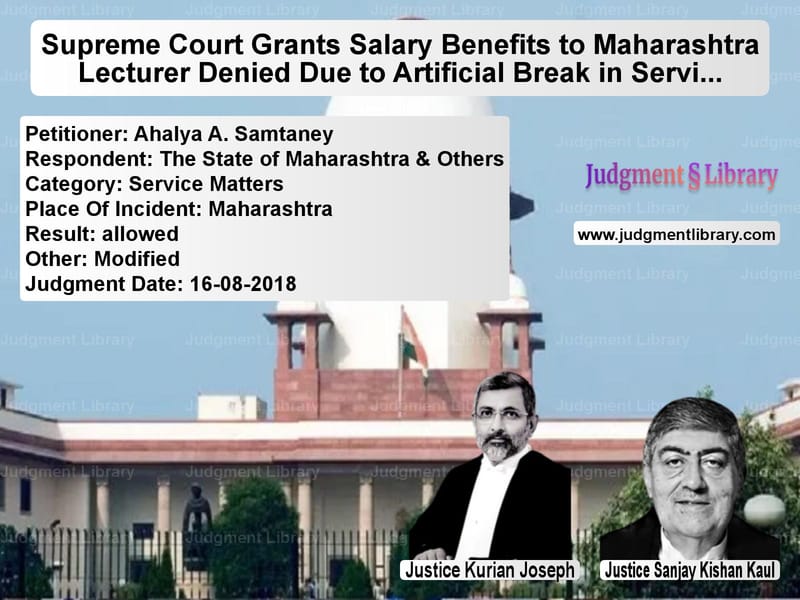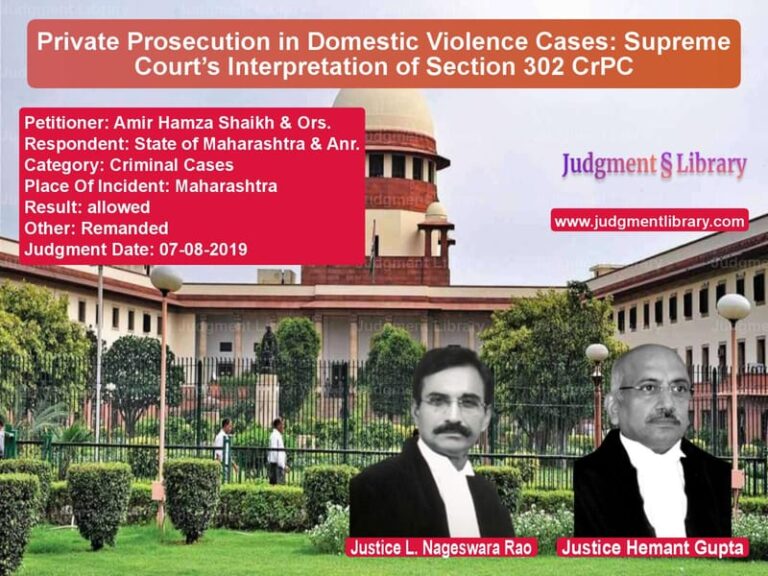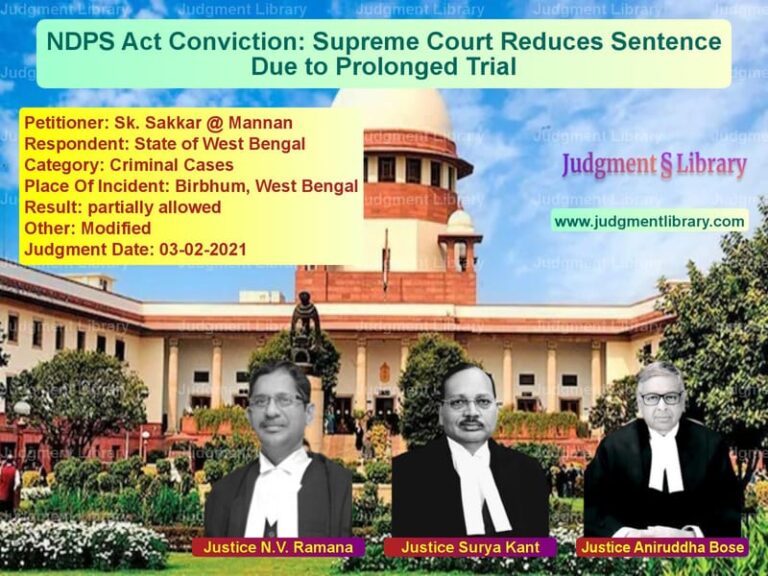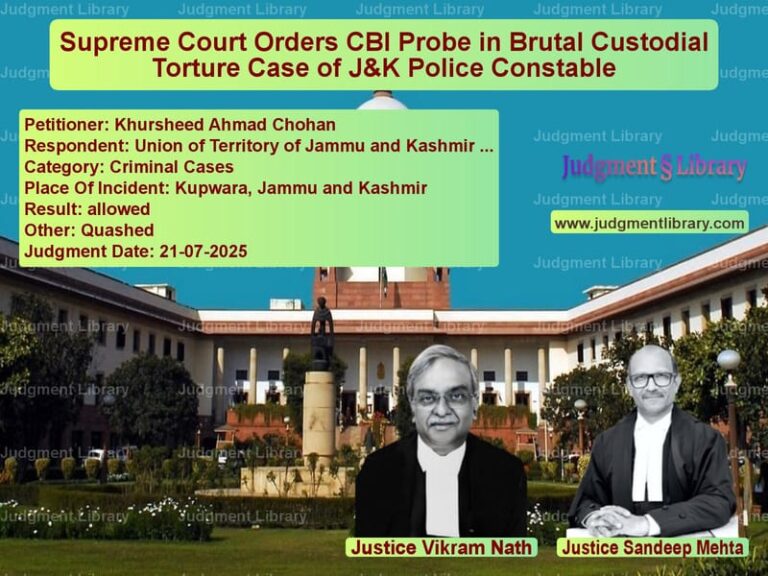Supreme Court Grants Salary Benefits to Maharashtra Lecturer Denied Due to Artificial Break in Service
The Supreme Court of India, in the case of Ahalya A. Samtaney v. The State of Maharashtra & Others, ruled in favor of a senior lecturer who was denied salary benefits due to an artificial break in service. The judgment, delivered on August 16, 2018, by a bench comprising Justice Kurian Joseph and Justice Sanjay Kishan Kaul, held that the petitioner was entitled to be placed in the correct pay scale as per government resolutions applicable to surplus teachers.
Background of the Case
The petitioner, Ahalya A. Samtaney, was a lecturer in English at H.R. College of Commerce and Economics, Mumbai. She was initially appointed as a tutor in 1974 and later promoted to a lecturer’s position in 1975. However, due to a shift in the education system from the 10+4 pattern to the 10+2+3 pattern in 1976, she was declared surplus in the senior college and subsequently appointed as a full-time teacher in the junior college from October 1, 1976. This transition led to her placement in a lower pay scale of Rs. 500-900 instead of Rs. 700-1600.
The petitioner argued that she was entitled to salary protection under a government resolution dated June 11, 1976, which ensured the absorption of surplus lecturers in junior colleges without financial loss. Despite multiple representations, her claim was not resolved, leading her to file Writ Petition No. 1840/1998 before the Bombay High Court, which was dismissed on grounds of delay and non-continuous service.
Petitioner’s Arguments
The petitioner, through her legal representatives, contended:
- She was continuously employed from 1974, and the transition from senior to junior college was due to government policy changes.
- The artificial one-day break in service on September 30, 1976, should not disqualify her from salary protection benefits.
- The Maharashtra Government’s resolution dated November 27, 1991, specifically granted salary protection to lecturers transferred from senior to junior colleges due to restructuring.
- She was wrongly placed in a lower pay scale despite being eligible for the Rs. 700-1600 scale.
- The High Court had erroneously dismissed her claim based on technical grounds without considering the substantive issue of salary disparity.
Respondents’ Arguments
The State of Maharashtra and other respondents countered:
- The petitioner’s service was not continuous due to the formal termination on September 30, 1976, and reappointment on October 1, 1976.
- The government resolutions cited by the petitioner applied only to lecturers with uninterrupted service.
- The High Court’s decision was justified as the petitioner approached the court after a delay of over two decades.
- The petitioner was given due promotions and benefits over the years, making further relief unnecessary.
Supreme Court’s Observations
The Supreme Court critically analyzed the case and made the following key observations:
- The artificial one-day break in service was a technicality created due to an administrative change and could not be used to deny legitimate benefits.
- The government resolutions intended to protect surplus lecturers from financial loss should be applied liberally.
- The petitioner had continuously served the institution from 1974 to her retirement in 2011 and was granted pension benefits, proving continuity of service.
- The High Court had erred in dismissing the petition solely on the grounds of delay without addressing the merits of the salary protection claim.
Final Judgment
The Supreme Court ruled:
- The petitioner was entitled to the salary scale of Rs. 700-1600 from the date of her initial absorption into the junior college.
- The Maharashtra Government must recalculate and pay all arrears within three months from the date of the judgment.
- In case of non-compliance, the government would be liable to pay 12% interest per annum on the arrears.
- The Bombay High Court’s decision was set aside.
- The appeal was allowed, granting full salary benefits to the petitioner.
Impact of the Judgment
This ruling had significant implications for teachers and government employees:
- Recognition of Artificial Breaks: The judgment set a precedent that artificial service breaks should not be used to deny legitimate salary benefits.
- Salary Protection for Surplus Employees: Government employees affected by policy changes must be financially protected.
- Judicial Intervention in Administrative Injustice: Courts have the power to rectify salary discrepancies caused by unfair administrative decisions.
Conclusion
The Supreme Court’s verdict in Ahalya A. Samtaney v. The State of Maharashtra & Others reaffirms the principle that employees should not suffer financial losses due to technical service breaks. By overturning the High Court’s decision and granting salary protection, the ruling serves as a crucial precedent for similar cases involving surplus government employees.
Petitioner Name: Ahalya A. Samtaney.Respondent Name: The State of Maharashtra & Others.Judgment By: Justice Kurian Joseph, Justice Sanjay Kishan Kaul.Place Of Incident: Maharashtra.Judgment Date: 16-08-2018.
Don’t miss out on the full details! Download the complete judgment in PDF format below and gain valuable insights instantly!
Download Judgment: Ahalya A. Samtaney vs The State of Maharas Supreme Court of India Judgment Dated 16-08-2018.pdf
Direct Downlaod Judgment: Direct downlaod this Judgment
See all petitions in Employment Disputes
See all petitions in Promotion Cases
See all petitions in Transfers Cases
See all petitions in Judgment by Kurian Joseph
See all petitions in Judgment by Sanjay Kishan Kaul
See all petitions in allowed
See all petitions in Modified
See all petitions in supreme court of India judgments August 2018
See all petitions in 2018 judgments
See all posts in Service Matters Category
See all allowed petitions in Service Matters Category
See all Dismissed petitions in Service Matters Category
See all partially allowed petitions in Service Matters Category







